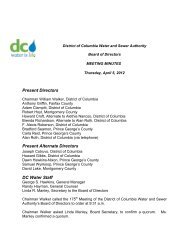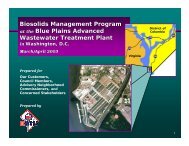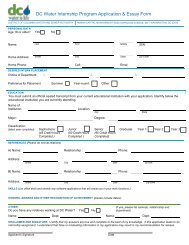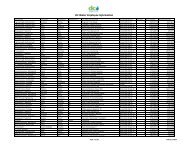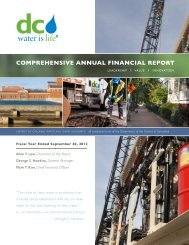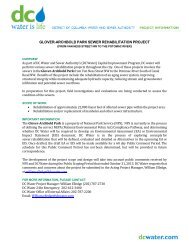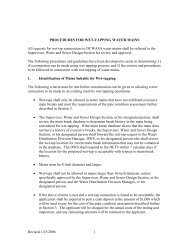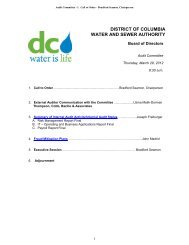Hist and Proj Operating Receipts FY 2011 2 17 2010 - DC Water
Hist and Proj Operating Receipts FY 2011 2 17 2010 - DC Water
Hist and Proj Operating Receipts FY 2011 2 17 2010 - DC Water
You also want an ePaper? Increase the reach of your titles
YUMPU automatically turns print PDFs into web optimized ePapers that Google loves.
modification to the permit reducing the total nitrogen effluent limit to 4.7 million pounds per year (equivalent to 4.2 mg/I at 370 mgd<br />
average annual flow). The capital projects required for Blue Plains to achieve the new permit limit are included in the proposed<br />
Capital Improvement Program. <strong>DC</strong> WASA has initiated final design of the Blue Plains Total Nitrogen <strong>Proj</strong>ect. Construction for the<br />
new projects, required for nitrogen removal <strong>and</strong> wet weather flow treatment, is scheduled to be completed in <strong>FY</strong> 2014 <strong>and</strong> <strong>FY</strong> 2018,<br />
respectively.<br />
The National Association of Clean <strong>Water</strong> Agencies (NACWA) has lauded Blue Plains on several occasions for its efficient<br />
wastewater treatment plant operations. Our work in this area is noted because of <strong>DC</strong> WASA's excellent record of compliance with<br />
federal regulations - a result of optimized operations <strong>and</strong> maintenance practices. In addition, <strong>DC</strong> WASA has been, <strong>and</strong> will continue<br />
to collaborate with a number of national <strong>and</strong> international research foundations, other wastewater treatment plant operators <strong>and</strong><br />
universities on wastewater <strong>and</strong> biosolids management research projects designed to answer operational questions <strong>and</strong> improve<br />
existing or develop new processes. These collaborative projects allow <strong>DC</strong> WASA to exp<strong>and</strong> its research capabilities <strong>and</strong> to foster<br />
peer-reviewed research. This research also contributes to the development of the next generation of wastewater treatment engineers<br />
<strong>and</strong> environmental scientists. An extensive discussion of our continuing research <strong>and</strong> partnerships is provided later in this document.<br />
<strong>DC</strong> WASA's 2008 Biosolids Management Plan that was approved by the Board of Directors in December 2008 hinges on the<br />
construction of the digestion facilities. The benefits of implementing the plan include producing a Class A biosolids product which<br />
can be more widely disposed of <strong>and</strong> actually be developed into a marketable product; the carbon footprint of the existing lime<br />
stabilization process will be reduced as there will be more than a 40-60% reduction in biosolids volume leaving the plant; <strong>and</strong> the<br />
facility will produce an estimated 13 MW of power that can easily be utilized on site. Efforts in <strong>FY</strong> 2009 have focused on<br />
incorporating new biosolids production numbers for up-coming unit process changes; finalizing the site layout <strong>and</strong> design criteria; <strong>and</strong><br />
determining the delivery method(s) of the biosolids management plan by early 2014. Specific objectives accomplished in <strong>FY</strong> 2009<br />
include:<br />
• Finalizing the delivery method <strong>and</strong> contracting mechanism for the Cambi thermal hydrolysis process<br />
• Review <strong>and</strong> update of the project economics. Once the system is operating on biogas from the digesters, it is anticipated <strong>DC</strong><br />
WASA would save over $25 million per year compared to the existing lime stabilization system.<br />
• A greenhouse gas study was conducted that evaluated the carbon footprint of <strong>DC</strong> WASA. This study showed the biosolids<br />
management plan would significantly reduce <strong>DC</strong> WASA produced greenhouse gases.<br />
Energy Management & Conservation Initiatives - Electricity continues to remain a major portion of the operating costs for <strong>DC</strong><br />
WASA. Budgeted at $29.3 million, or 11 percent of our $271.1 million revised <strong>FY</strong> <strong>2010</strong> operations <strong>and</strong> maintenance budget, this<br />
fiscal year did yield some price softening due to national economic conditions <strong>and</strong> international energy commodity prices. The<br />
expenditure for <strong>FY</strong> 2009 was $26.7 million as compared to $32.1 million for <strong>FY</strong> 2008. As the graph below depicts, electricity pricing<br />
has shown its first decline since its continuous rise from 2005 to 2008. Our view is that the slight decline in electricity prices is<br />
Budget Overview <strong>and</strong> Performance<br />
11-37



